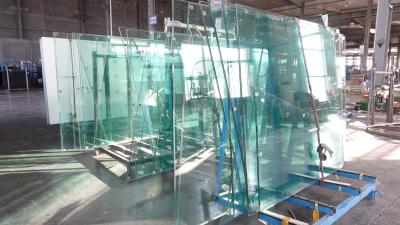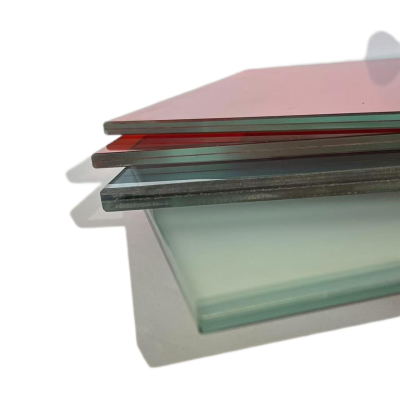What Are The Factors Affecting The Energy Efficiency Of Insulating Glass
Thickness of the glass:
The heat transfer coefficient of insulating glass is directly related to the product of the thermal resistance of the glass (the thermal resistance of the glass is 1mK/W) and the thickness of the glass. When increasing the thickness of the glass, it will inevitably increase the blocking ability of the piece of glass to heat transfer, thereby reducing the heat transfer coefficient of the entire insulating glass system. Calculation of ordinary insulating glass with 12 mm air spacing layer, when both pieces of glass are 3 mm white glass, K = 2.745W/m2K, both 10 mm white glass, K = 2.64 W/m2K, a reduction of about 3.8%, and the change in K value and the change in glass thickness is basically a linear relationship. From the calculation results, it can also be seen that the effect of increasing glass thickness on reducing the K value of insulating glass is not very large, and the combination of 8+12+8 is only 0.03 W/m2K lower than the commonly used combination of 6+12+6, which has little effect on building energy consumption. Insulating system composed of heat-absorbing glass or coated glass, the change is similar to white glass, so the analysis of other factors in the following will be based on the commonly used 6mm glass.
Type of glass:
The types of glass that make up the hollow are white glass, heat-absorbing glass, sun control coating, Low-E glass, etc., as well as the deep processing products produced by these glasses. The optical thermal properties of the glass will change slightly after being heat bent and tempered, but there will be no significant changes to the hollow system, so only the original glass without deep processing is analyzed here. The energy-saving characteristics of different types of glass vary greatly when used in a single piece, and when synthetic hollow, the combination of various forms will also show different changing characteristics.
Heat-absorbing glass is colored by the body to reduce the transmission rate and increase the absorption rate of solar heat, and because the air flow rate on the outdoor glass surface will be greater than that indoors, it can take away more of the heat from the glass itself, thus reducing the degree of solar radiation heat entering the room. Different color types and different shades of heat-absorbing glass will cause the SHGC value and visible light transmission rate of the glass to change greatly. However, the heat-absorbing glass of various color series has the same emissivity as ordinary white glass, which is about 0.84. Therefore, the heat transfer coefficient K value is the same when the insulating glass is composed of the same thickness. Several representative 6mm thickness heat-absorbing glass from different manufacturers are selected, and the hollow combination is heat-absorbing glass + 12mm air + 6mm white glass
Emissivity of Low-E glass:
The heat transfer coefficient of Low-E glass is directly related to the emissivity of its film surface. The smaller the emissivity, the higher the reflection rate of far infrared rays, and the lower the heat transfer coefficient of the glass will be. For example, when the radiance of the film surface of 6mm single Low-E glass is 0.2, the heat transfer coefficient is 3.80 W/m2K; when the radiance is 0.1, the heat transfer coefficient is 3.45 W/m2K. The change of K value of single glass will inevitably cause the change of K value of insulating glass, so the heat transfer coefficient of Low-E insulating glass will change with the change of radiance of low radiation film layer. The data shown in Figure 3 shows the change in the K value of the insulating glass subject to the change in the radiance of the film layer when the combination of 6+12+6 is used for white glass and Low-E glass. It can be seen that when the emissivity is reduced from 0.2 to 0.1, the K value is only reduced by 0.17 W/m2K. This indicates that the change in K value of Low-E insulating glass is not very significantly affected by the emissivity compared with the change of single Low-E.
Type of interstitial gas:
The thermal conductivity of insulating glass is about 1½% lower than that of a single piece of glass, which is mainly the effect of the gas spacer layer. Insulating glass filled with gas inside in addition to air, there are argon, krypton gas and other inert gases. Due to the low thermal conductivity of the gas (air 0.024W / mK; argon 0.016W / mK), so greatly improve the thermal resistance of the insulating glass performance. 6 + 12 + 6 white glass hollow combination, when filled with air K value of about 2.7 W / m2K, filled with 90% argon K value of about 2.55 W / m2K, filled with 100% argon K value of about 2.53 W / m2K Compared to the two inert gases, argon is more abundant in air, easier to extract and less expensive to use, so it is more widely used. No matter what kind of gas is filled, the SHGC value and visible light transmission rate of insulating glass remain basically the same under the same thickness.
The thickness of the gas spacer layer.
Commonly used insulating glass spacer layer thickness of 6mm, 9mm, 12mm, etc.. The thickness of the gas spacer layer is directly related to the size of the heat transfer resistance. In the case of the same glass material, sealing structure, the larger the gas spacer layer, the greater the heat transfer resistance. But after the thickness of the gas layer reaches a certain level, the growth rate of heat transfer resistance is very small. Because when the thickness of the gas layer increases to a certain extent, the gas will produce a certain convection process under the effect of temperature difference between the glass, thus reducing the effect of thickening the gas layer. When the gas layer increases from 1mm to 9mm, the K value decreases by 37% when the white glass hollow is filled with air, 53% when the Low-E hollow glass is filled with air, and 59% when it is filled with argon gas. From 9mm to 13mm, the rate of decline starts to slow down. 13mm later, the K value has a slight rebound. Therefore, for 6mm thickness glass hollow combination, the thickness of the gas spacer layer over 13mm will not produce significant energy saving effect.
Modern architecture in the pursuit of practical functions, based on the increasing requirements of architectural aesthetics, glass curtain walls can be presented in different shades of sunlight and show dynamic beauty with changes in sunlight, lighting, etc.. With the continuous progress of science and technology, the varieties and functions of glass are becoming more and more colorful, and energy-saving insulating glass, as the leader of new glass, can effectively reduce the energy loss of building exterior windows, and thus meet the energy-saving needs of the entire building project. In today's construction of a conservation-oriented society, the promotion of energy-saving building materials will become a key element in promoting the sustainable development of our society. The promotion and use of energy-saving insulating glass meets the demand for building energy efficiency and accelerates the early realization of green buildings. With the increasing expansion of modern residential windows and doors and the shortage of natural resources, energy-saving insulating glass has a broad development prospect both in the domestic market and in the international market.


































































































































































































